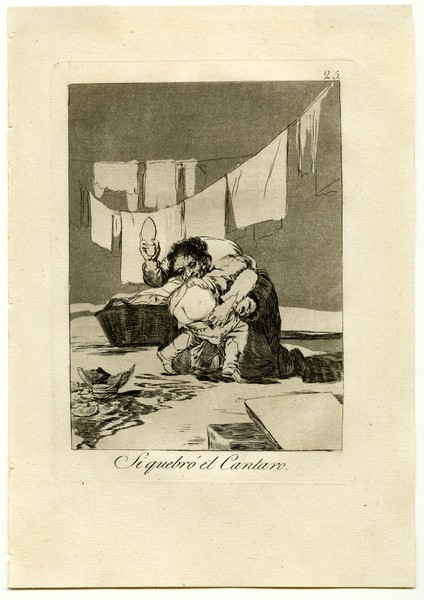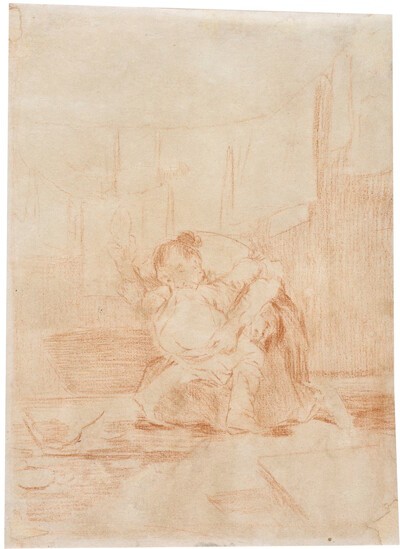- Cronología
- Ca. 1797 - 1799
- Dimensiones
- 209 x 152 mm
- Técnica y soporte
- Aguafuerte, aguatinta y punta seca
- Reconocimiento de la autoría de Goya
- Attributed work
- Ficha: realización/revisión
- 01 Dec 2010 / 29 May 2024
- Inventario
- 225
If you broke the pitcher. (at the bottom)
25. (in the upper right-hand corner)
See Francisco de Goya y Lucientes, Painter.
Four state proofs are known to exist before the letter in which the child's bare bottom was not modelled anywhere. Goya later added a few dry-point touches to give it a more rounded shape. On one of these proofs, the one in the Bibliothèque Nationale de France in Paris, the lower part of the manuscript reads This is how the wrongdoer is paid, although this title was changed, as can be seen in another state proof in which good calligraphy is used to serve the handwriting engraver.
A preparatory drawing for this engraving is preserved in the Prado Museum in Madrid.
In the middle of the engraving, a woman with a rather coarse face is beating a child with a shoe, and we can see her face with a pained expression. In the background there are clothes hanging on two ropes, as well as a basket, which leads us to think that the woman was doing the laundry. The reason for the beating is that the boy has broken a pitcher, which lies shattered in the foreground.
The three manuscripts explaining the engravings in the series of The Caprices emphasise the mother's disproportionate reaction to the child's mischief.
Education was, in the minds of the Enlightenment, the foundation on which to build the happiness and progress of any society. It is possible that this Goyaesque engraving has to do with an anecdote told by the editor of The Censor, a Madrid newspaper known to Goya's circle of enlightened friends. The latter reported that he had once entered a friend's house and caught him beating his son. He asked him what was the cause of this punishment, to which the father replied that his son had broken a Chinese cup. In the aforementioned newspaper, it was common to hear anecdotes of this kind criticising the excessive nature of certain punishments. These punishments did more harm than good, as they confused children's ability to discern real wrongdoing. In addition, Goya may have echoed the theories of Johann Heinrich Pestalozzi (Zurich, 1746-Brugg, 1827) against punishment as a pedagogical method.
The education of children appears in many other engravings in this series, as well as in the painting entitled The letter with blood enters, in which the painter captures a scene in which a child is brutally taught in a school.
The plate is preserved in the National Chalcography (no. 196).
-
Goya. Gemälde Zeichnungen. Graphik. TapisserienKunsthalle BaselBasle1953from January 23th to April 12th 1953cat. 215
-
Goya. La década de Los CaprichosMadrid1992organized by Real Academia de Bellas Artes de San Fernando sponsored by Fundación Central Hispano, Madrid, consultant editor Nigel Glendinnig. From October 26th 1992 to January 10th 1993cat. 46
-
Francisco de GoyaMuseo d'Arte ModernaLugano1996exhibition celebrated from September 22nd to November 17th.cat. 25, p.52
-
Ydioma universal: Goya en la Biblioteca NacionalBiblioteca NacionalMadrid1996from September 19th to December 15th 1996cat. 127
-
Francisco Goya. Sein leben im spiegel der graphik. Fuendetodos 1746-1828 Bordeaux. 1746-1996Galerie KornfeldBern1996from November 21st 1996 to January 1997cat. 31
-
Goya e la tradizione italianaFondazione Magnani RoccaMamiano di Traversetolo (Parma)2006consultant editors Fred Licht and Simona Tosini Pizzetti. From September 9th to December 3th 2006cat. 25, p.152
-
Goya. Opera graficaPinacoteca del Castello di San GiorgioLegnano2006exhibition celebrated from December 16th 2006 to April 1st 2007p.30
-
Goya et la modernitéPinacothèque de ParisParís2013from October 11st 2013 to March 16th 2014cat. 141
-
Goya: Order and disorderMuseum of Fine ArtsBoston2014cat. 50
-
Hamburg2019cat. 37
-
2022
-
Goya engravings and lithographs, vol. I y II.OxfordBruno Cassirer1964p.95, cat. 60
-
Vie et ouvre de Francisco de GoyaParísOffice du livre1970p.179, cat. 500
-
Goya, la década de los caprichos: dibujos y aguafuertesMadridReal Academia de Bellas Artes de San Fernando1992pp.77-79, cat. 46-47
-
Catálogo de las estampas de Goya en la Biblioteca NacionalMadridMinisterio de Educación y Cultura, Biblioteca Nacional1996p.87, cat. 113-114
-
El libro de los caprichos: dos siglos de interpretaciones (1799-1999). Catálogo de los dibujos, pruebas de estado, láminas de cobre y estampas de la primera ediciónMadridMuseo Nacional del Prado1999pp.164-167
-
Francisco Goya. Los CaprichosBarcelonaEdiciones de la Central2011pp.40-42
-
ParísPinacoteca de París2013p. 203
-
Goya: Order & DisorderBostonMuseum of Fine Arts Boston Publications2014p. 116
-
Goya. In the Norton Simon MuseumPasadenaNorton Simon Museum2016pp. 42-75
-
HamburgHirmer2019p. 249
-
Museo de Bellas Artes de Badajoz y Diputación de Badajoz2022p. 38

